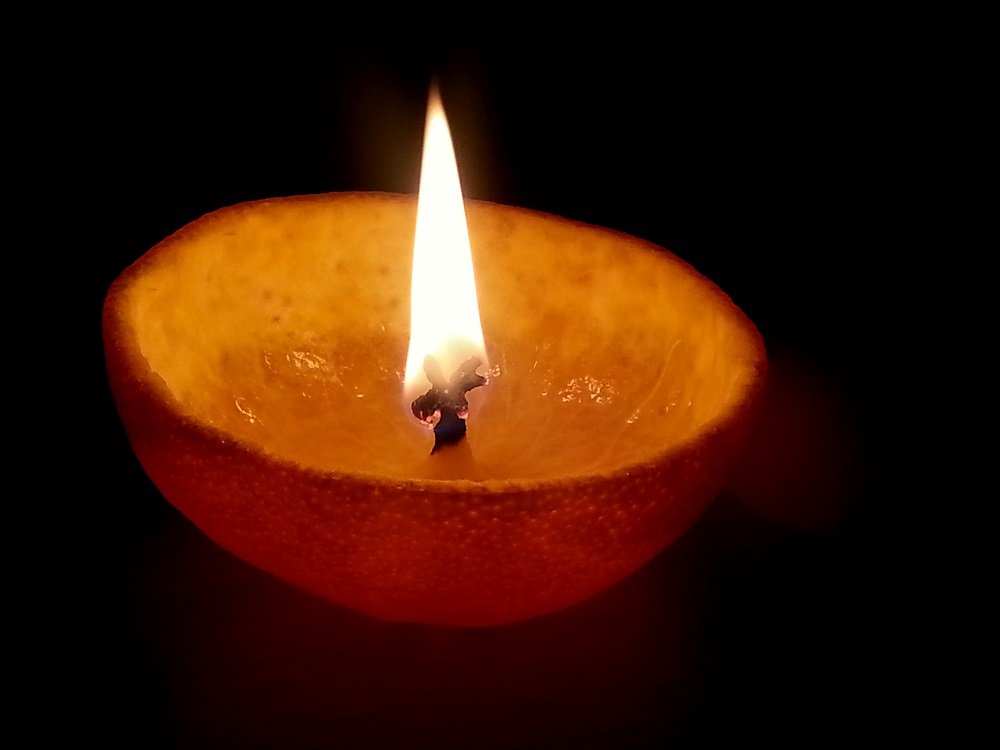Oil lamps are gorgeous, and they provide such romantic lighting, but they don’t always smell great. Perhaps there’s something you can do about that at home, like adding an essential oil. Is that safe, or should you steer clear of messing with your fuels? The answer depends largely on the type of oil lamp you’re using. It’s important to understand that alcohol and kerosene or paraffin lamps are oil lamps, just like those that avail themselves of actual vegetable oils. Fortunately, once you understand how fuel-burning lights work, you can certainly look into additives like an essential oil. I’ll explain it step by step, so you know both how, and what you can add to your oil lamps safely. There are a surprising number of options available to fuel and scent lamps once you know where to look.
Can you add essential oils to lamp oil? You can add essential oil to lamp oil. However, the scent of different oils certainly burns differently, and some may not smell as strongly as you’d like. Fortunately, you don’t need to start from scratch when working out what to add. Most vital are safety and using high-quality oils.
Lamp Oil 101: Before You Add Essential Oils
There are two primary considerations about your lamp before you can add essential oils to your lamp oil. Simply adding fire to flammable fuel isn’t enough. At least, not if you want to be safe. The fuel source and maintenance both make a massive difference in how your particular lamp works.
You might not think it’s essential to understand how an oil lamp works. Unfortunately, you’d be wrong. Because we no longer commonly use these lamps everywhere, this basic skill is no longer passed down. The beautiful, sooty lights you see on historical TV shows are a great example of how not to treat an oil lamp.
A poorly cared for oil lamp can build up a gas pocket and explode. What does that have to do with adding essential oils, you ask? Everything. For example, some oils, like orange, are incredibly combustible, and therefore they can make these terminal failures even more likely if you don’t know how to care for your lamp.
Choose a light, fragrant oil like Pure & Natural Therapeutic Grade Sandalwood for your first blend. The larger bottle will keep your lamps glowing with aromatic and smartly harvested oil from trusted sources. Find out more on Amazon when you click here.
Fuel Source
The earliest oil lamps used fuel sources like whale oil, camphine, and fat to stay alight. However, as anyone who has spilled bacon grease on a stove can tell you the smell of burning animal products can get stinky fast. Moreover, camphine is turpentine distilled with lime. Hence, making lamp fuel smell better is an ancient idea.
These days you have plenty of options for your oil lamps. Which one you choose is mostly up to you as they will all burn in a lamp with a wick. Please do not mix different lamp oils. Instead, if you plan to change your fuel source, clean all the residue out of your oil reservoir, and use a new wick.
Fuels have varying flashpoints. Hence they burn at different temperatures and rates of consumption. That means they catch alight and burn in unique ways. Consequently, mixing can lead to severe issues unless you’re a fuel expert.
Fuel Options
There are several fuels you can use for your oil lamp. Each one has it’s advantages, and most do well with essential oil additives—however, a word of caution. You should never use gasoline, rubbing alcohol, or mineral oil in an oil lamp.
- Palm Kernel Oil- This odorless and non-toxic oil is safe to use around the house. Because it is non-toxic, it’s a good choice for homes with pets and children. Regrettably, it’s also one of the harder oils to find.
- Olive Oil or Lampanate- Much less refined than the olive oil you see in grocery stores, Lampanate is merely virgin olive oil that is not pure enough for human consumption. Renewable, smokeless, and odorless, olive oil is easy to find and safe to use around furry friends and young people. Although you may need to retrofit a lamp with a thick wick to use olive due to the low burning point, Lampanate is a smart and ecologically sound fuel.
- Lamp Oil- If you use lamp oil, then you’ll want a cap for your oil lamp when it’s not in use to prevent evaporation. This purified hydrocarbon oil comes in various colors and scents made just for oil lamps.
- Kerosene- This oil produces a very bright flame and is readily available. Moreover, kerosene is cost-effective and does well with essential oil additives.
- Fish Oil- I do not recommend fish oil because of the smell. Additionally, it tends to produce a lot of soot and smoke when burned. Unless you’re seeking a traditional oil lamp for a reenactment, skip the fish products and choose a better option.
- Castor Oil- Castor bean oil is a popular vegetable-based oil that will work beautifully in any oil lamp. Plus, it’s a renewable resource and easy to mix essential oils into.
- Canola Oil- You probably already have this in your cupboards for baking. Canola or rapeseed oil should be a last resort for filling oil lamps because it can often cause the wick to clog up. Alternately, if you only plan to use your lamp once or very infrequently, canola may be an excellent option to add essential oils because of the consistency.
Not all fuels will wok for all lamps. Please consult your manual or a professional before simply pouring ‘whatever’ into an oil lamp. Some require retrofitting for alternate fuel sources, while others are more versatile.
Maintenance
Cleaning your oil lamp’s hood is vital. A buildup of soot or condensation can become dangerous. After each use, let your lamp cool thoroughly before removing the hood. Wipe it with a soft cloth. You can use a mild dish detergent like Dawn to degrease any oily areas.
Before lighting a lamp, make sure that none of the fuel is spilled. Though most lamp fuels won’t ignite easily without a wick, it’s still necessary to clean up before you light up. Additionally, make sure you keep lit lamps somewhere safe where the heat won’t damage anything nearby.
Clean your air along with your lamp when you choose Eve Hansen USDA Certified Organic Eucalyptus Essential Oil. Eucalyptus has long been known to help people breathe easier. Nausea and stress relief are just part of the many benefits of this organic oil. Get this refreshing oil on Amazon when you click here.
Lamp Wick
A proper lamp wick should be an eighth of an inch at all times. You will need to trim your wick every three to four hours to keep your oil lamp working correctly. Although it’s a small thing, doing this assures that your oil lamp is burning the right amount of fuel at all times.
Not only is trimming a safety issue, but it prevents unnecessary fuel waste. Think of it like changing the batteries in a rechargeable flashlight. Though it doesn’t take much effort, it is essential if you want your light to continue functioning. Especially if you keep scented lamps for emergencies, you don’t want to discover a problem at the worst possible moment.
Adding Essential Oil to Lamp Oil
When adding essential oils to your lamp oil, always start with the minimum. Since each oil is different, small batch mixing is best. I suggest taking only as much as your lamp requires and blending in three to five drops of your oil of choice. By doing this, you won’t waste much if the oil burns to create an unpleasant smell.
Stir in the oil until it’s well blended and then pour it into the lamp. Once your oil lamp is lit, wait about twenty minutes to assess the scent. If it’s not strong enough, then double your number of drops once the lamp has cooled completely.
Keep in mind the fuel already in the wick will be from the previous batch. Hence it could take an hour or two before you start to smell the new blend. Mark any oil containers with the name of your scent, so you’ll know which is which. You can easily find stickers to label your jars online or in shops that sell office and craft supplies.
Make sure you write down how many drops you put in for future reference. I recommend keeping a small notebook on hand just for this purpose. Store your notes with the lamps and oils for easy reference.
Test out some high-quality oils from the Pura D’or 16pc Essential Oils Wood Box Set. With plenty of USDA certified organic oils to choose from, you can make the blend of your dreams. Plus, you get a-hundred-percent satisfaction guarantee with Pura D’or. Learn more on Amazon when you click here.
Kerosene & Essential Oils
Unlike most oils, kerosene is a little different when it comes to blending in your essential oils. Like most, you should start with just a few drops. However, you should never add more than one teaspoon of essential oil per eight ounces of kerosene.
For a lovely, sweet, and minty smell, try out Artizen Peppermint Essential Oil in your lamps. This undiluted, therapeutic grade oil will bring a fresh scent to your home. As an added benefit, peppermint is known to help reduce headaches and repel pests like mice and spiders. Get yours from Amazon when you click here.
Storing Oil Lamps and Lamp Oil
Add essential oils to your lamp oil when you first open it and make sure to mix carefully. If the original container is plastic, it is best to transfer your lamp oil into a glass container for long term storage. Storing your lamps and oil is incredibly easy.
Make sure you keep both lamps and oil containers out of direct sunlight. It’s best to store them in dry, room temperature, or slightly cooler conditions. Do not ever freeze lamp oil.
Calming Majestic Pure Lavender Oil from Amazon comes in a beautiful brown glass bottle. The darker glass stores well and preserve the oil inside. Moreover, the glass dropper makes it easy to measure out your essential oil for lamps. To see the outstanding ratings for yourself, click here.
Final Thoughts
Adding essential oil to lamp oil isn’t a new idea, but it is an excellent one. Customizing your space through aroma is one of those unforgettable personal touches. Human memory is deeply connected to scent.
Just as lamplight can create a mood, taking it a step further with an aromatic upgrade is a brilliant way to add that little something extra to your home. Choose essential oils that suit your decor and the season for the best results. Additionally, make sure you mark your lamp oil containers with the scent so you can find what you need later, and feel free to play with lots of different essential oils to see what works best for you.
Essential oils in your oil lamps can be more than merely a pleasant scent. Try adding aromatherapy oils to help improve your mood, or get a good night’s sleep.

